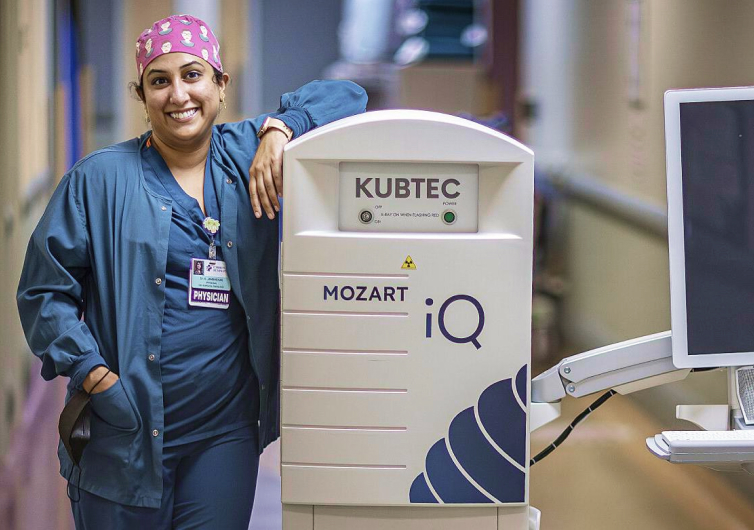New Provider Making Strides With New Tech At Christus
7/25/2024 9:39 PM
By Kylie Garcia kgarcia@sfnewmexican.com Jul 22, 2024

Christus St. Vincent Regional Cancer Center welcomed a new provider earlier this year who has hit the ground running with technology that is making strides in breast cancer treatment.
The Mozart iQ 3D Margin Management System system gives breast oncology surgeons a clearer view of cancerous margins in breast tissue, allowing them to remove the cancer in its entirety. It was brought to the administration’s attention by Dr. Amani Jambhekar, who was using the technology in Houston before coming to New Mexico to serve as Christus St. Vincent’s medical director of surgical breast oncology in February.
Jambhekar, going on her fifth year of practice, completed her fellowship at Columbia University in New York and worked in private practice in Houston for four years. She was the only woman in her graduating class as she completed her general surgery residency.
“I didn’t want to be in a field where we’re doing things just because my mentor told me they’re doing it or this is how I was trained to do it,” she said. “I wanted to be in a field that was constantly growing and evolving and was really centered around evidence-based medicine, and so, for me, breast surgical oncology really fit those criteria.”
Jambhekar, who also holds a master’s degree in business administration, worked with the radiography system during her fellowship and was able to convince the Houston hospitals she worked at to buy it after presenting them with research on its return on investment. A clearer view of margins means all the cancer is removed during the first try, leaving no need for additional surgeries.
Upon coming here, this technology was one of her first requests.
“I decided to come to New Mexico because it was an opportunity to be a medical director and grow a breast and melanoma program. And I really wanted to bring the standard of care that we have in Houston to New Mexico,” Jambhekar said.
Christus St. Vincent was quick to grant her $250,000 request.
“We definitely utilized her expertise. ... She knew all the newest technology because she worked with clinical trials and research, so she was really very familiar with the best expertise and equipment in breast surgeries,” said Genevieve Tarnow, oncology service line executive director at Christus St. Vincent.
Prior to using the Mozart system, the standard of care was to utilize traditional two-dimensional technology. According to Jambhekar, the difference between the 2D and 3D images are vastly different.
“You get a lot more clarity on exactly what you’re looking at in the breast tissue,” Jambhekar explained. “This is basically a 3D mammogram for the lump that is removed from the breast. So I can look in three dimensions and see, ‘Did I get all the cancer out?’ And if I feel like I didn’t, I can remove more at the time of surgery rather than bringing the patient back for a whole other surgery, which can be really traumatic for patients.”
Bringing the same three-dimensional views that are now considered standard of care for breast cancer detection, said Jambhekar, to the operating room during breast cancer treatment has proven to be effective both in studies and in Jambhekar’s experience.
“Knock on wood, I’ve never had a positive margin after a lumpectomy. So 100% of the time when I do a lumpectomy to go in and get cancer, I remove it, and that’s pretty unusual. Nationally, the positive margin rates are probably around 20%. Here in Santa Fe, it’s probably even grown a bit higher than that unfortunately,” Jambhekar said.
“A positive margin is really bad for the patient because it means cancer stayed in their body,” Tarnow said. “[Dr. Jambhekar] has never had a positive margin for lumpectomy cases, and so that’s something she tracks and that is part of what the equipment helps her achieve.”
While many surgeons are starting to utilize this new technology, Jambhekar said the innovation has not yet dominated the market as some providers are concerned about how to integrate it into their practices and understand how to use it.
Two of Santa Fe’s only other surgical breast oncologists are among those hesitant to jump on board, Jambhekar said.
“They are a little more comfortable with the old-school technology ... which is a shame because I think that if we have technology that’s available, that’s innovative, it makes sense to utilize it, but you know, to each their own,” said Jambhekar, who said she would put the system in every hospital performing breast cancer surgeries if she could.
Jambhekar did say shifting from using 2D imaging to 3D could present a bit of a learning curve, but that it was the support of her mentors and administrations that made the difference.
The 3D imaging technology also presents a hurdle as far as being more expensive than traditional 2D systems. Jambhekar said this is an investment that will save money, decrease the number of additional surgeries and help patients in the long run.
“At the cancer center, we are trying to raise the bar on standards of care and quality, so this falls perfectly in line with what we’re trying to do because we weren’t utilizing this technology here at Christus St. Vincent,” Tarnow said. “So now we’re able to increase our margin rate, which is huge, and just have better outcomes for patients.”
Having established this standard of care at Christus, Jambhekar said she is now on a mission to recruit other surgical breast oncologists and providers to New Mexico.
“It’s a really special place that has a lot of potential,” Jambhekar said.
